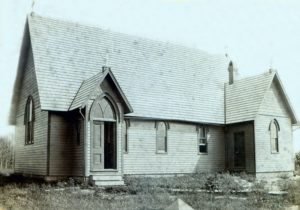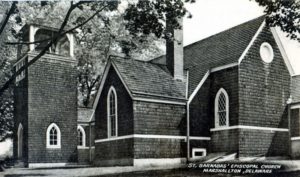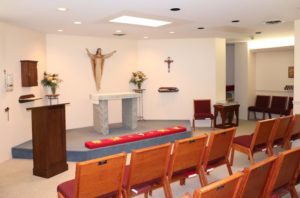History of St. Barnabas’ Episcopal Church, Delaware
by Judy Reinicker and others
St. Barnabas’ Episcopal Church in Delaware began as a church school of St. James Episcopal Church in Newport before 1890. At first the congregation met in each other’s homes under the lay leadership of William J. Robinson. It was organized as a church mission on December 17, 1890 with the Rev. Edward H. Eckel [or Eckels], rector of Old St. James’, celebrating the first Eucharist, Mr. Robinson, only 29 years old, and W. W. Sudders were Wardens.
Original Church Building in Marshallton. On May 18, 1892, William Robinson, a superintendent at Marshallton Iron Works, was thrown from a railroad car and hit by an engine. He tragically died several days later of his injuries. A week later, a committee was chosen to raise funds for a chapel in memory of Mr. Robinson.
The Chapel was named Trinity Memorial Chapel, as a mission of St. James’ Parish. By June, $600 had been raised and a lot purchased at Kiamensi and Newport Roads in Marshallton.
The cornerstone was laid on October 29 [or October 22], 1892. On May 12, 1893, the church was dedicated by Bishop Leighton Coleman and given the name St. Barnabas’. In 1898 this building burned to the ground on Christmas Eve. The rebuilding was done by members of the church. The new building (which still stands in Marshallton) was erected and consecrated on June 27, 1899.
A new bell and belfry was dedicated by Rev John Rigg in May 1911. A bronze plaque in memory of the mission was installed in the tower May 1911. William George Lord, a Delaware Senator and grandfather of Alfreda Clinton, was the Warden at the time and Frederick Bringhurst was the Treasurer. The bell was rung at the beginning of services. The neighbors protested the bell, especially when it rang at 8:00 am Sunday mornings. Charlie Anderson, Polly’s husband, liked to swing up and down with the rope as he rang the bell! Many of the parishioners lived in the general area and membership grew. The church was the center of their social activities as well as a place to worship.
In 1932 a parish house building was added to the church. The cornerstone was laid on June 17, 1932 and the hall was dedicated on October 9, 1932. Aid was received from the Diocesan Missionary Department and the parishioners had also saved a considerable sum on their own. There was a large hall with a kitchen at one end and a stage at the other. There were lots of dinners, parties and games. Chief cooks were Guelda Raeburn, her husband Bob, and Marie Dennison. Every one pitched in to help. The annual Strawberry Festival was very popular and a good fund raiser. The hall was large enough for the men to play basketball, and there also was a softball team. A big bazaar was held in November and a big dinner before the Thanksgiving holiday. There was an active Young People’s group that had its own dinners and parties either in the Parish Hall or in members’ homes. Carol Broadbent remembers making wreaths for all of the church windows at Christmas time and decorating the church.
St. Barnabas’ mission became a parish on April 18, 1950. Alvin B. Potter, Acting Rector in Charge, along with the officers and members of the vestry, signed the certificate of incorporation naming the church St. Barnabas’ Episcopal Church, Marshalltown, Delaware.
The first rector was Rev. Jack Smith, who came in May 1950. Linda Hardy describes him as a very handsome, charismatic man, energetic and eccentric. He prepared her for confirmation and she said his preparations were clear and understandable, and at the same time funny and personable. On occasion he would let himself into the houses of altar guild members, throw his vestments into their washer, and sit down to have some coffee.
In 1955, 26 acres of valuable commercial land on Kirkwood Highway was given to the parish by Frederick Bringhurst and this financed the moving of the parish which had outgrown the building. Frederick Bringhurst was the son of John R. Bringhurst, the owner of Marshallton Iron Works. He was born in 1873 and served as President of the firm from 1898 to 1906. He was 20 when he started teaching Sunday School. In 1922 he organized the first Boy Scout Troop in Delaware. The St. Barnabas’ Scout troop was the longest continuous scout troop in the country. Frederick Bringhurst was very active in the church. He was Church Treasurer in the beginning, and then for the next fifty years he served as Treasurer of the Diocese. He died January 6, 1955. In his will he gave St. Barnabas’ Church “all of my real estate located in and about Marshallton being wholly within Mill Creek Hundred, New Castle County, State of Delaware.” It consisted of 26 acres of land that he owned on Kirkwood Highway, a triangular piece of property bounded by Kirkwood Highway, Greenbank and Duncan Roads.
A New Building for a New Time. In 1957, the Reverend Cloud C. Rutter was called as the second rector. At this time, it was obvious membership was outgrowing the space of the old church. Linda Hardy said at Christmas and Easter they had to put extra chairs in the aisles, and the vestry felt it was time to build a bigger church. Dallas Helwig suggested that they sell the land they were given and buy land in a growing residential area. The vestry agreed. They sold the land on Kirkwood Highway for $250,000, bought nine acres on Duncan Road, and had enough money left to start building a church. Dallas Helwig did the work of selling the land they were given, buying the land on Duncan Road, and supervising the building of the new church.
Everyone worked to raise money for the new church. In addition to their usual projects, they served dinners at the Lions Club meetings to raise money for the new kitchen.
The Marshallton church was deconsecrated in 1962 and sold. There was a cemetery in back of the church with tombstones dating back to 1889. When the vestry sold the church, they kept the cemetery, and parishioners took care of cutting the grass and maintaining it. That soon became impractical, and it was deeded to the new owners of the church. The church is now owned by the Kings Assembly of God.
When the decision was made to build a new church, Rev. Rutter wanted a cross-section of members on the committee to plan the new church. Sherry Pecorini, who had small children at the time, is the only member of the committee still attending St. Barnabas’. Rev. Rutter was very specific about wanting a church in the shape of a cross. He wanted a free standing altar and a three dimensional cross to hang above the altar and face everyone in the church no matter where they sat. In order to show the Planning Committee what he had in mind he had a model of the cross made. The price was deductible from the final cost. When they saw that the price of the model was higher than they expected, they were easily persuaded to accept the architects who designed the model and save the money they had already spent.
Ground was broken for the new church on Duncan Road October 9, 1960. Samuel and Victorine Homsey of Wilmington were the architects, and W. D. Haddock Construction Co., the contractor. The Rt. Rev. J. Brook Mosley, Bishop of the Diocese of Delaware laid the date stone on June 11, 1961.
The first service in the new building was a baptism on December 17, 1961. Charles Todderud remembers sitting on folding chairs at first but by January 11th 1962 the pews made of African Mahogany had arrived and were installed. The first Sacrament of Holy Communion was celebrated Christmas Eve 1961 by Bishop J. Brooke Mosley, Bishop of Delaware. The church was dedicated November 28, 1963 by Bishop Mosley.
The parishioners continued with the many activities they had had at the old church. There were many covered dish dinners and social gatherings. There was a group called Epis-Co-Pals that met once a month on Fridays as a night out for parents, no children allowed. Rev. Rutter encouraged them to have a New Year’s Eve party. The Broadbents first organized it, and then turned it over to Charlie Anderson and Cathy Scarborough. All contributed food and drink. In the beginning they met at 8 pm with a short service in the church before going downstairs for the festivities. Dick Broadbent remembers some of the bands that entertained them: Al Santora and the Highlanders, Mark Brown and Earl Green’s band. Later they danced to records spun by Clay Rutter. When the group got smaller, they met in each other’s homes.
In 1963 activities were divided among the following special committees: Church School, Adult Discussion, Christian Social Relations, Evangelism, Finance, Laymen, Maintenance, Stewardship, Episcopal Church Women, Workshop and Youth Committee.
In 1963-64 the annual church picnics were held at St. Andrews School where we could play games, swim and boat and have fun with the whole family. This continued off and on until the early 1980s. A Rogers organ was installed May 12, 1963 and dedicated November 29, 1963. It was replaced in 1988 when James and Carol Blackburn donated an Allen Classic II Organ in memory of Lawrence H. and Rose E. Miller. Bells were added to the organ by Dale Hiller as a memorial to his wife Mary in April 1996. Dorothy Raymond, organist and choir leader resigned and 1964 and Marian Sutter was hired. In 1967 Evelyn Bowman became organist. She retired on 1970. Virginia Hudson was hired as organist and choir director in 1985. She resigned in 1991 and Dave Smith and Tom Sabatino took over as organist and choir director, resp. In 1993, Norman Thompson as hired as organist and choir director. He served until he resigned in 2004. Dr. Michael Larkin was hired in June of 2004 as Director of Music Ministry.
In 1963, Margaret Slocomb and Josephine Smith chaired the first Christmas Bazaar to raise funds for the church’s outreach programs, and it has become an annual affair. Everyone contributed. There were many homemade items, baked goods, used articles, etc. Charles Todderud remembers the year when there had been considerable vandalism. Bullet holes were found in the front door, and there were other acts of vandalism. The Vestry decided to take no chances with all the treasures that came in for the bazaar, so they took turns staying overnight at the church the night before. One of the men brought a gun. At 5:00 in the morning there was considerable noise at the back door so the men, including the one with the gun, went to scare off the intruder. They were very embarrassed when they found it was Harry Walton, the Scout Master, coming in to get supplies from the kitchen for the Scout trip that day.
In 1971, a flag pole was purchased by Charles and Polly Anderson as a special memorial to their son Charles Richard Anderson who was killed in Viet Nam when his helicopter crashed while patrolling the Ho Chi Minh Trail. The pole was installed by members of the West Wilmington Optimist Club. Two oak trees had to be removed because of the amount of cement needed to anchor it. Many of the trees in the front of the church had been planted as special memorials. If ashes were buried with them, the ashes were later removed to the Memorial Garden.
On May 2, 1976 the vestry called a special meeting of all parishioners to discuss the need for additional space that could be used for educational purposes. A special committee was set up by the vestry to research the needs of the parish. Its conclusion was to give top priority to expanding the educational program. A sketch of a proposed addition to the present church, and a plan for financing the extension were presented. It was then moved that: “The Congregation of St. Barnabas’ Episcopal Church endorses the plan to add classrooms and certain other service areas and directs the Vestry to proceed with the plan as outlined on May 2, 1976.”
Carol Broadbent, elected in 1977 as Senior Warden, was the first female Senior Warden at St. Barnabas’.
Ground was broken June 19, 1977 for the education wing with an office and lounge. Bob Evans was the architect. The vestry sold three acres for approximately $55,000 to the developer of Sherwood Park, De Ascanio, who planned to cut them into 15 plots for houses that would face the church. There was a good deal of controversy over the sale of the land, objections from Sherwood Park residents and a need for rezoning. The church sold $100 bonds to the parishioners and paid them off as contributions came in. A builder was hired and the parishioners did much of the work.
Ground was broken for the Education Wing on June 19, 1977. It was dedicated on June 18, 1978 by the Right Reverend William Hawley Clark. A new administrative wing was dedicated in June, 2009 to the memory of Associate Priest the Rev. William Merrill.
After 26 years of dedicated service to the church, the Reverend Rutter retired in 1983. From 1985 to 1989 the Reverend Edward M. Ranck served as rector. The current rectory was built during his service to St. Barnabas’ in 1987. He was followed by The Reverend George Karney, now Rector Emeritus, 1990 to 2000. A chapel was added in 1995 during Fr. Karney’s tenure.
The Rev. Robert J. Broesler was called as Rector in 2001. Recognizing the need for more office and lounge space, a Capital Campaign was begun, and ground was broken in 2008 for new offices, remodeling the lounge, adding a kitchenette and bathroom.
The Rev. Peter B. Huiner served as Bishop’s Vicar from May, 2009 to May, 2011, after which the Rev. John B. Pumphrey began serving as priest-in-residence until June of 2013. The Rev. Edwin C. Pease, Jr. served as interim priest from June, 2013 to June, 2014. The Rev. Martha Kirkpatrick was called as rector in June 2014 and served until April of 2019. The Rev. David Beresford served as our interim rector from June of 2019 to August 2020. In January of 2021, we welcomed our current Rector The Rev. Kenn Katona.
The church building was designed by Samuel and Victorine Homsey of Wilmington to highlight the new emphasis of the Liturgical Movement. It is built in the traditional cruciform shape and a church-in-the-round with the free-standing altar in the center. It is set with the jeweled cross of sacrifice, being offered to God by the people on all sides, holding it aloft to the skylighted roof. This type of worship is reminiscent of the early Christians who worshipped around their altars.
The very structure of the church underlines the key words of our parish philosophy—Worship, Education, Fellowship, Participation. As the surrounding area develops further, St. Barnabas’ Church continues to grow through strong leadership of both clergy and laity.
[envira-gallery slug=”history”]



